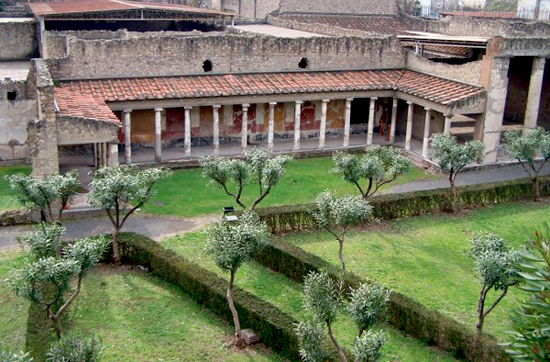



The excavations of Oplontis are located in the center of the modern city of Torre Annunziata. The name Oplontis is only attested in the Tabula Peutingeriana, a medieval copy of an ancient map of the Italian roads of the Roman Empire, in which Oplontis indicates some structures located between Pompeii and Herculaneum.

A series of archaeological finds, actually related to a suburban area of ​​Pompeii, have been attributed to Oplontis:
- a residential villa, the villa of "Poppea";
- a rustic villa attributed to L. Crassius Tertius, in which, alongside numerous bodies of victims of the eruption, a considerable quantity of gold and silver coins was found, together with numerous pieces of the finest goldsmith's art;
- a thermal structure, at the Oncino, under the current Terme Nunziante, attributed by A. Maiuri to the consul M. Crassus Frugi.

The main monument, the only one that can be visited, is the villa of Poppea, included among the assets that UNESCO has defined as a "World Heritage Site". Built towards the middle of the first century. BC, was enlarged in the imperial age, and was already being restored at the time of the eruption. Its property is attributed to Poppea Sabina, second wife of the emperor Nero, but in any case belonging to the patrimony of the imperial family.

Among the Vesuvian archaeological sites, buried following the dramatic eruption of 79 AD, Oplontis is probably the one that offers the most significant monumental evidence of the Pompeian suburb.

The set of buildings of the Roman age found, a beginning from the Bourbon period, in the modern city of Torre Annunziata, is referable to a real peripheral urban center, subject to the administrative jurisdiction of Pompeii.

What characterizes Oplontis is the presence of two monumental buildings of destination: villa A (so-called Villa di Poppea), a grandiose and luxurious residential complex and villa B (by L. Crassius Tertius), currently not open to the public. , corresponding to a company whose activity was centered on the processing of land products, in particular wine and oil.

Currently the only visitable monument of ancient Oplontis is a large residential villa, not entirely brought to light, dating back to the mid-first century BC. and enlarged in the early imperial age. In ancient times the villa overlooked the sea in a panoramic position and was equipped with splendid decorative elements of which exceptional testimonies are preserved.

It could have belonged to Poppaea Sabina, second wife of Emperor Nero, or to his family's heritage, based on the testimony of an inscription painted on an amphora mentioning Sucundus, one of his slave or freedmen. At the time of the eruption the building must have been largely uninhabited due to work in progress, perhaps started following seismic damage, which involved the removal of many architectural and decorative elements.
Villa of Poppea, excavations of Oplontis
Address: Via Sepolcri, 80058
Phone: +39 081 857 5347
Site:
http://pompeiisites.org/en/oplontis/Location inserted by
giulia